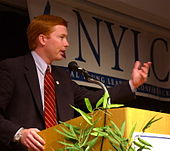Global Young Leaders Conference
The Global Young Leaders Conference is an annual, two-week meeting of young people from around the world who are viewed as future leaders. The aim of the conference is to develop appropriate leadership qualities in a global context.
conference
Attendees
Participants are between 16 and 18 years old and come from all over the world. They are selected by their school on the basis of their leadership personality and proposed for participation or determined through performance-related selection processes. At GYLC, they will have the opportunity to exchange ideas with some of the world's most important leaders, to work together actively on simulations of international politics and to get to know new people and cultures. Valuable experience should be passed on and leadership qualities strengthened.
carrier
The GYLC is organized by the Congressional Youth Leadership Council (CYLC). This is a not for profit, impartial education organization founded in 1985 and located in Washington, DC. It is part of Envision EMI, LLC , which is based in Vienna, Virginia . To date, more than 200,000 young people from over 100 countries have participated in the CYLC programs. CYLC is a non-profit organization whose aim is to support young people and to enable them to have contact and experience with young people from all over the world.
subjects
The main theme of the program is "The Leaders of Tomorrow Preparing for the Global Challenges and Responsibilities of the Future". His main areas are:
- Global communication
- diplomacy
- Law
- Human rights
- Peace and security
- economy
- The role of the United Nations
procedure



The main program ( core program ) of the conference consists of three components ("three S"):
- Speaker events
- Here the participants get to know influential leaders from politics, business and NGOs . Usually this takes place in the form of a presentation, panel discussion and subsequent question and answer session.
- Sightseeing
- The participants visit government institutions, embassies and international organizations, but also cultural sights and educational institutions.
- Simulation
- Within the entire core program, two simulations are used in which the participants simulate the two most important organs of the United Nations, similar to MUN . In the first simulation, a resolution on an international conflict has to be worked out as the UN Security Council, while in the final Global Summit all groups of countries come together and together as the UN General Assembly discuss a wide variety of resolutions on global problems that have previously been worked out by various commissions .
During the rest of the time, items on the day are prepared, discussed, or other activities planned in so-called Leadership Group Meetings (LGM). In addition, most of the country group work takes place here. B. working together on resolutions for a simulation. Each LGM group represents a specific country in the simulations and is supervised by a Faculty Advisor (FA). The LGMs are also intended to promote cohesion, since the evening program can also be organized here in smaller groups. B. introduce each other to their different cultures and countries of origin.
In addition to the core program, there is the option of enrolling for a pre-program as well as a so-called cultural add-on . While the pre-program is intended to prepare for the main program and bring the participants closer together, the cultural add-on is a casual follow-up program that consists of visiting the sights of the conference venue.
Venues
The conference takes place every summer in three different locations:
- USA : Washington, DC and New York City
- Europe : Vienna , Budapest and Prague
- Asia : Beijing and Shanghai

